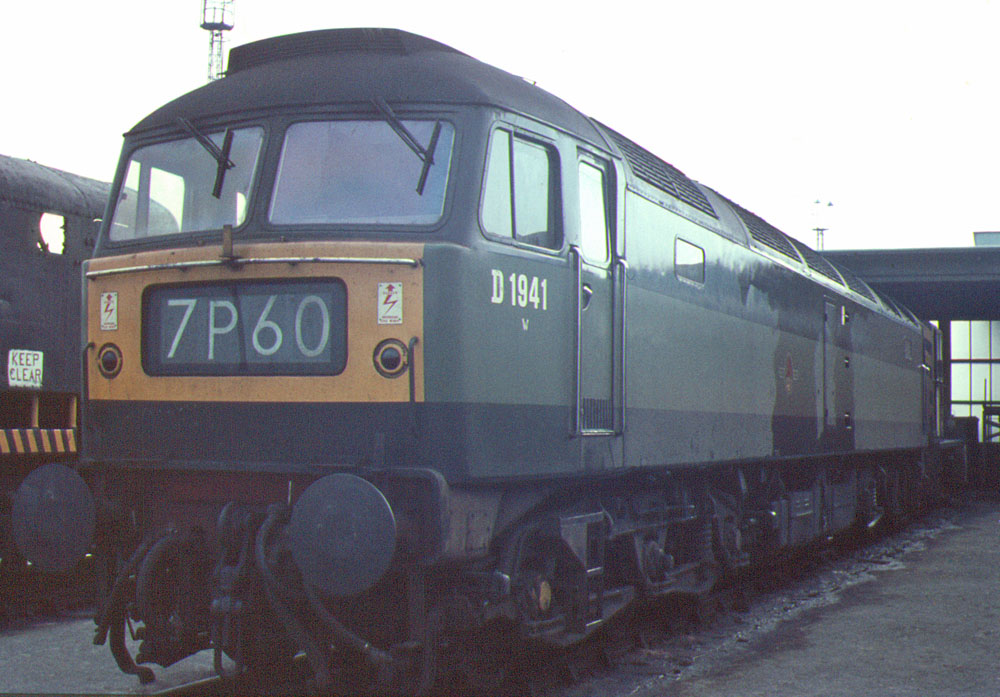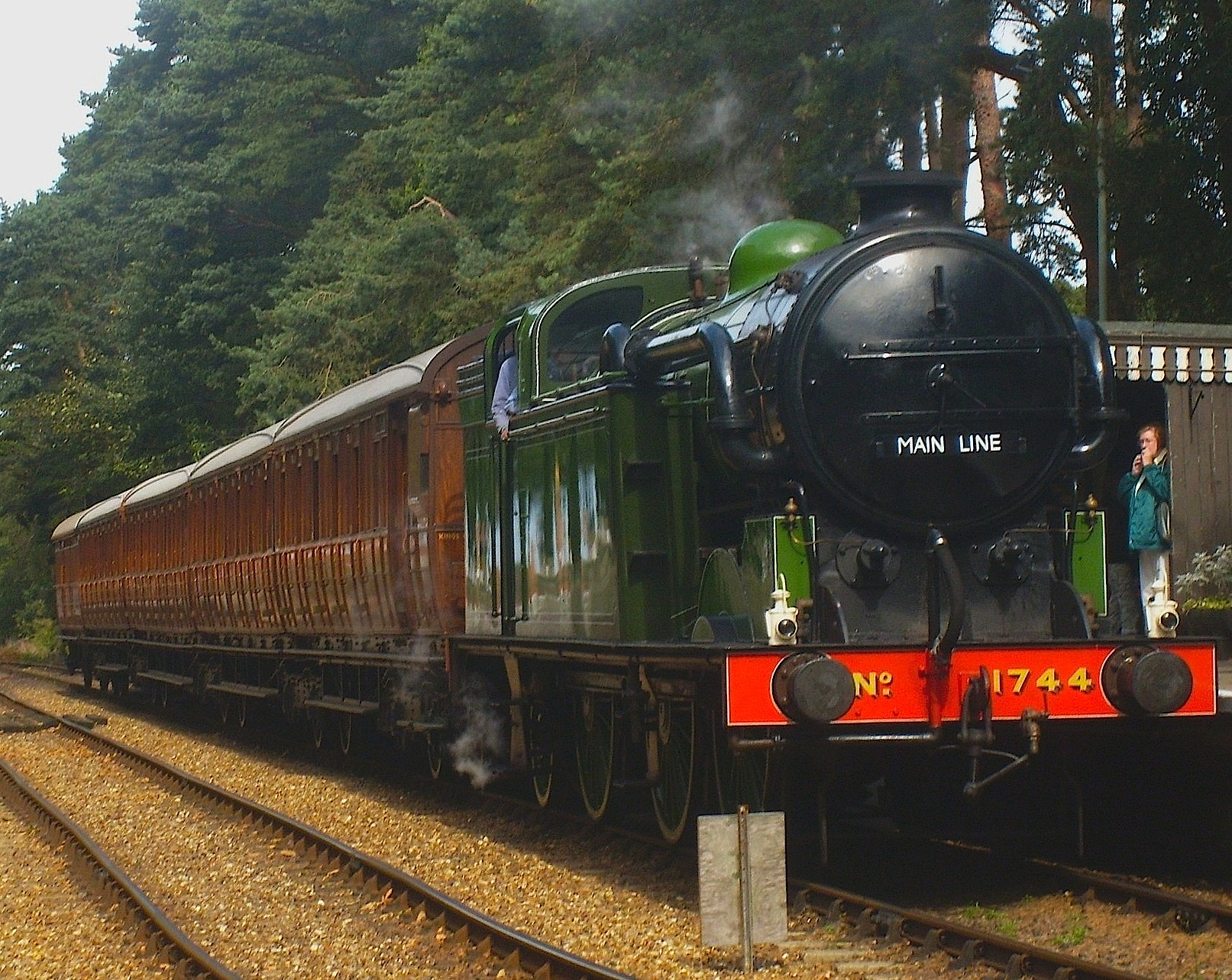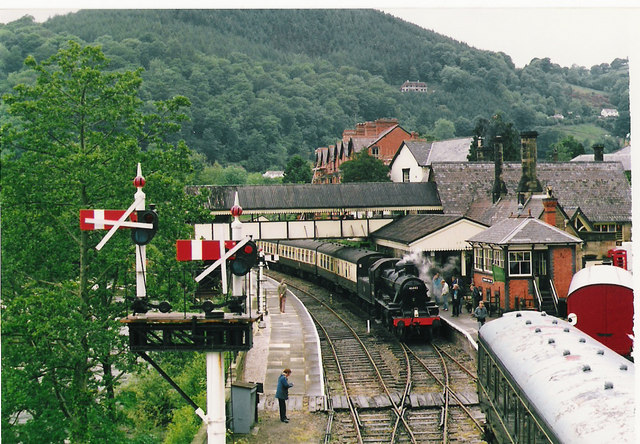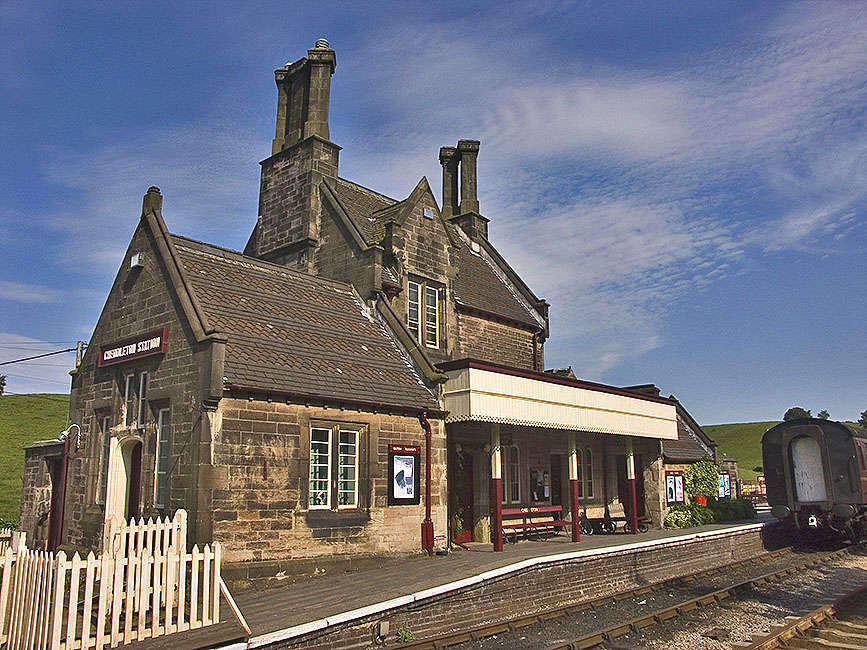|
British Rail Class 104
The British Rail Class 104 diesel multiple units were built by Birmingham Railway Carriage and Wagon Company from 1957 to 1959. A product of British Rail's Modernisation Plan of 1954, the 104s were designed for general branch line and commuter routes. The first units ordered were for the London Midland Region, with the majority of the class for use in North West of England. The Class 110 was a re-engineered version of the 104 with more powerful engines, but did not last as long in service. The 104s had asbestos insulation removed during the 1970s. Operations Greater Manchester The 104 was introduced on 17 June, 1957. The type was seen regularly on services from Manchester to Buxton, Marple, New Mills and Blackpool. The 104 was ideal for these routes as the lightweight chassis were well suited to the hilly lines in the northwest of England. A regular sight in the Greater Manchester area for over 30 years, the 104s were replaced by Sprinters by 1990, with the last running on 4 M ... [...More Info...] [...Related Items...] OR: [Wikipedia] [Google] [Baidu] |
Birmingham Railway Carriage And Wagon Company
The Birmingham Railway Carriage and Wagon Company (BRC&W) was a railway locomotive and carriage builder, founded in Birmingham, England and, for most of its existence, located at nearby Smethwick, with the factory divided by the boundary between the two places. The company was established in 1854. Production BRC&W made not only carriages and wagons, but a range of vehicles, from aeroplanes and military gliders to buses, trolleybuses and tanks. Nevertheless, it is as a builder of railway rolling stock that the company is best remembered, exporting to most parts of the new and old worlds. It supplied vehicles to all four of the pre-nationalisation "big four" railway companies (London, Midland and Scottish Railway, LMS, Southern Railway (UK), SR, London and North Eastern Railway, LNER and Great Western Railway, GWR), British Rail, Pullman Company, Pullman (some of which are still in use) and Compagnie Internationale des Wagons-Lits, Wagons-Lits, plus overseas railways with diver ... [...More Info...] [...Related Items...] OR: [Wikipedia] [Google] [Baidu] |
British Rail Class 47
The British Rail Class 47 or Brush Type 4 is a class of diesel-electric locomotive that was developed in the 1960s by Brush Traction. A total of 512 Class 47s were built at Brush's Falcon Works in Loughborough and at British Railways' Crewe Works between 1962 and 1968, which made them the most numerous class of British mainline diesel locomotive. They were fitted with the Sulzer 12LDA28C twin-bank twelve-cylinder unit producing though this was later derated to to improve reliabilityand have been used on both passenger and freight trains on Britain's railways for over 55 years. Despite the introduction of more modern types of traction, a significant number are still in use, both on the mainline and on heritage railways. As of December 2021, 78 locomotives still exist as Class 47s, including 31 which have been preserved. 33 further locomotives were converted to Class 57s between 1998 and 2004. Origins The Class 47 history begins in the early 1960s with the stated aim of ... [...More Info...] [...Related Items...] OR: [Wikipedia] [Google] [Baidu] |
East Lancs Railway
East Lancashire Railway is a heritage railway line in North West England which runs between Heywood, Greater Manchester and Rawtenstall in Lancashire. There are intermediate stations at Bury Bolton Street, , Summerseat and Ramsbottom, with the line crossing the border into Rossendale serving Irwell Vale and Rawtenstall. Before closure, the line terminated at Bacup. Overview Passenger services between Bury and Rawtenstall were withdrawn by British Rail on 3 June 1972. Coal services to Rawtenstall ended in 1980 and formal closure of the line followed in 1982. The East Lancashire Railway Trust reopened the line on 25 July 1987. The initial service operated between Bury and Ramsbottom, via Summerseat. In 1991, the service was extended northwards from Ramsbottom to reach Rawtenstall, via Irwell Vale. However, two original stations on the line, closed to passengers by BR in 1972, have not reopened, Ewood Bridge & Edenfield and Stubbins. The latter was the junction of the lines ... [...More Info...] [...Related Items...] OR: [Wikipedia] [Google] [Baidu] |
North Norfolk Railway
The North Norfolk Railway (NNR) – also known as the "Poppy Line" – is a heritage steam railway in Norfolk, England, running between the towns of Sheringham and Holt. The North Norfolk Railway is owned and operated as a public limited company, originally called Central Norfolk Enterprises Limited. The railway is listed as exempt from the UK Railways (Interoperability) Regulations 2000. History Route history The line once formed part of the Midland and Great Northern Joint Railway's Melton Constable to Cromer Beach branch line. The first section, from Melton to Holt, was opened on 1 October 1884. After a suspension of work, the Holt to Cromer section of line was completed by direct labour, and opened on 16 June 1887. A through Kings Cross to Cromer express started running in August 1887, and although the construction had been expensive, the boost to revenue from the new line was considerable. A second train was put on the following year, in the down direction cons ... [...More Info...] [...Related Items...] OR: [Wikipedia] [Google] [Baidu] |
Telford Steam Railway
The Telford Steam Railway (TSR) is a heritage railway located at Horsehay, Telford in Shropshire, England, formed in 1976. The railway is operated by volunteers on Sundays and Bank Holidays from Easter to the end of September, and at Christmas. Its official business name is the Telford Horsehay Steam Trust (THST), and it is a registered charity. History Telford Steam Railway operates over a portion of the Wellington and Severn Junction railway (W&SJR). The line to Lightmoor and beyond to Buildwas was constructed by the Wenlock, Craven Arms and Lightmoor Extension railway. Both of these became a part of the Wellington to Craven Arms Railway. For most of its working life the line was operated by the Great Western Railway and subsequently the Western Region of British Railways. The line directions between Buildwas and Lightmoor were counter-intuitive for a period when the line going down the hill was the Up Line (towards London), and the line going up the hill was the Down Li ... [...More Info...] [...Related Items...] OR: [Wikipedia] [Google] [Baidu] |
Llangollen Railway
The Llangollen Railway () is a volunteer-run heritage railway in Denbighshire, North Wales, which operates between Llangollen and Corwen. The standard gauge line, which is long, runs on part of the former Ruabon – Barmouth GWR route that closed in 1965. It operates daily services in the summer as well as weekends throughout the winter months, using a variety of mainly ex-GWR steam locomotives as well as several diesel engines and diesel multiple units. A extension of the railway has been built to complete the line to Corwen. In March 2021 the railway company announced that, having made a loss in three consecutive years, they had invited their bank to appoint receivers. History Commercial Service: 1865–1962 Llangollen was already a popular place for tourists by the 1840s. Travel up to this time had been by horse-drawn carriage, but by the 1840s the Shrewsbury to Chester line had been completed, which allowed passengers to alight at (later known as Whitehurst Halt), an ... [...More Info...] [...Related Items...] OR: [Wikipedia] [Google] [Baidu] |
East Lancashire Railway
East Lancashire Railway is a heritage railway line in North West England which runs between Heywood, Greater Manchester and Rawtenstall in Lancashire. There are intermediate stations at Bury Bolton Street railway station, Bury Bolton Street, , Summerseat railway station, Summerseat and Ramsbottom railway station, Ramsbottom, with the line crossing the border into Borough of Rossendale, Rossendale serving Irwell Vale railway station, Irwell Vale and Rawtenstall railway station, Rawtenstall. Before closure, the line terminated at Bacup railway station, Bacup. Overview Passenger services between Bury and Rawtenstall were withdrawn by British Rail on 3 June 1972. Coal services to Rawtenstall ended in 1980 and formal closure of the line followed in 1982. The East Lancashire Railway Trust reopened the line on 25 July 1987. The initial service operated between Bury, Greater Manchester, Bury and Ramsbottom, via Summerseat. In 1991, the service was extended northwards from Ramsbotto ... [...More Info...] [...Related Items...] OR: [Wikipedia] [Google] [Baidu] |
Churnet Valley Railway
The Churnet Valley Railway is a preserved standard gauge heritage railway in the Staffordshire Moorlands of Staffordshire, England. It operates on part of the former Churnet Valley Line.which was opened by the North Staffordshire Railway. The railway is roughly long from Kingsley and Froghall to Ipstones. The land from Leek Brook Junction to Ipstones was opened by Moorland & City Railways (MCR) in 2010 after they took a lease out from Network Rail. This has subsequently been purchased by the Churmet Valley Railway. The main stations along the line are Kingsley and Froghall, Consall, Cheddleton and Leek Brook (which is only used as a run around loop). Work has begun to extend the line to the town of Leek which will act as the northern terminus of the line. The line between Leek and Waterhouses has also been reopened as part of the heritage railway far as Ipstones. Preservation history Early days of preservation: Cheddleton station (1964–1977) The Cheshire and S ... [...More Info...] [...Related Items...] OR: [Wikipedia] [Google] [Baidu] |
British Rail Class 37
The British Rail Class 37 is a diesel-electric locomotive. Also known as the English Electric Type 3, the class was ordered as part of the British Rail modernisation plan. They were numbered in two series, D6600–D6608 and D6700–D6999. The Class 37 became a familiar sight on many parts of the British Rail network, in particular forming the main motive power for InterCity services in East Anglia and within Scotland. They also performed well on secondary and inter-regional services for many years. Many are still in use today on freight, maintenance, and empty stock movement duties. The Class 37s are known to some railway enthusiasts as "tractors", a nickname given due to the similarities between the sound of the Class 37's engine and that of a tractor. Description Background As part of the large scale dieselisation brought about by the British Rail modernisation plan a need was identified for a number of type 3 locomotives of power output to . English Electric had alre ... [...More Info...] [...Related Items...] OR: [Wikipedia] [Google] [Baidu] |
Diesel Multiple Unit
A diesel multiple unit or DMU is a multiple-unit train powered by on-board diesel engines. A DMU requires no separate locomotive, as the engines are incorporated into one or more of the carriages. Diesel-powered single-unit railcars are also generally classed as DMUs. Diesel-powered units may be further classified by their transmission type: diesel–mechanical DMMU, diesel–hydraulic DHMU, or diesel–electric DEMU. Design The diesel engine may be located above the frame in an engine bay or under the floor. Driving controls can be at both ends, on one end, or in a separate car. Types by transmission DMUs are usually classified by the method of transmitting motive power to their wheels. Diesel–mechanical In a diesel–mechanical multiple unit (DMMU), the rotating energy of the engine is transmitted via a gearbox and driveshaft directly to the wheels of the train, like a car. The transmissions can be shifted manually by the driver, as in the great majority of first-gen ... [...More Info...] [...Related Items...] OR: [Wikipedia] [Google] [Baidu] |
Railway Technical Centre
The Railway Technical Centre (RTC) in London Road, Derby, England, was the technical headquarters of the British Railways Board, and was built in the early 1960s. British Rail described it as the largest railway research complex in the world. The RTC centralised most of the technical services provided by the regional Chief Mechanical & Electrical Engineers (CM&EE) to form the Department of Mechanical & Electrical Engineering (DM&EE). In addition, it housed the newly formed British Rail Research Division which reported directly to the Board. The latter is well known for its work on the experimental Advanced Passenger Train (APT-E). At that early stage this was a concept vehicle, and in time the DM&EE applied the new knowledge to existing practice in the design of the High Speed Train (HST), the later prototype APT-P and other high-speed vehicles. History Opening The Research Division was the first to move into the purpose-built accommodation on London Road. This was formed initi ... [...More Info...] [...Related Items...] OR: [Wikipedia] [Google] [Baidu] |
Scotland
Scotland (, ) is a country that is part of the United Kingdom. Covering the northern third of the island of Great Britain, mainland Scotland has a border with England to the southeast and is otherwise surrounded by the Atlantic Ocean to the north and west, the North Sea to the northeast and east, and the Irish Sea to the south. It also contains more than 790 islands, principally in the archipelagos of the Hebrides and the Northern Isles. Most of the population, including the capital Edinburgh, is concentrated in the Central Belt—the plain between the Scottish Highlands and the Southern Uplands—in the Scottish Lowlands. Scotland is divided into 32 administrative subdivisions or local authorities, known as council areas. Glasgow City is the largest council area in terms of population, with Highland being the largest in terms of area. Limited self-governing power, covering matters such as education, social services and roads and transportation, is devolved from the Scott ... [...More Info...] [...Related Items...] OR: [Wikipedia] [Google] [Baidu] |








.jpg)
